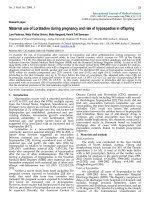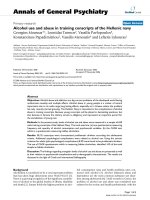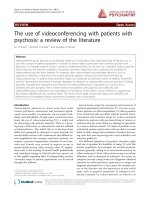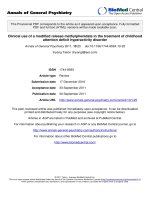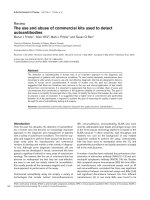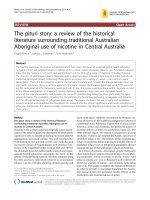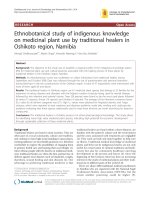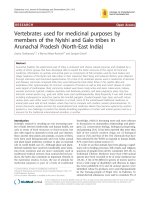Báo cáo y học: "The use of medicinal plants in the transhimalayan arid zone of Mustang district, Nepal" pps
Bạn đang xem bản rút gọn của tài liệu. Xem và tải ngay bản đầy đủ của tài liệu tại đây (492.36 KB, 11 trang )
RESEARC H Open Access
The use of medicinal plants in the trans-
himalayan arid zone of Mustang district, Nepal
Shandesh Bhattarai
1,2*
, Ram P Chaudhary
2
, Cassandra L Quave
3
, Robin SL Taylor
4
Abstract
Background: This study documents the use of medicinal plants from the Mustang district of the north-central part
of Nepal. Traditional botanical medicine is the primary mode of healthcare for most of the population of this
district and traditional Tibetan doctors (Amchi) serve as the local medical experts.
Methods: Field research was conducted in 27 communities of the Mustang district in Nepal from 2005-2007. We
sampled 202 interviewees, using random and snowball sampling techniques. After obtaining prior informed
consent, we collected data through semi-structured interviews and participant-observation techniques. Voucher
specimens of all cited botanic species were deposited at TUCH in Nepal.
Results: We recorded the traditional uses of 121 medicinal plant species, belonging to 49 vascular plant and 2
fungal families encompassing 92 genera. These 121 species are employed to treat a total of 116 ailments. We
present data on 58 plant species previously unknown for their medicinal uses in the Mustang district. Of the
medicinal plants reported, the most common growth form was herbs (73%) followed by shrubs, trees, and
climbers. We document that several parts of individual plant species are used as medicine. Plant parts were
generally prepared using hot or cold water as the ‘solvent’, but occasionally remedies were prepared with milk,
honey, jaggery, ghee and oil. Amchis recommended different types of medicine including paste, powder,
decoction, tablet, pills, infusion, and others through oral, topical, nasal and others routes of administration.
Conclusions: The traditional pharmacopoeia of the Mustang district incorporates a myriad of diverse botanical
flora. Traditional knowledge of the remedies is passed down through oral traditions and dedicated apprenticeships
under the tutelage of senior Amchi. Although me dicinal plants still play a pivotal role in the prim ary healthcare of
the local people of Mustang, efforts to ensure the conservation and sustainable use of medicinal species are
necessary.
Background
Plants and plant products are the p rimary source of
medicine and a highly valued resource in Nepal. Plant
constituents continue to be a vital part of Western med-
icine, and are still considered an important source of
novel compounds in the field of drug discovery [ 1].
There are between 35,000 and 70,000 plant species that
have been used for medicinal purposes in the world [2],
and about 6,500 species of which occur in Asia [3]. In
Nepal, at least 1,600 to 1,900 species of plants are com-
monly used in traditional medicinal practices [4,5].
Traditional medicine in Nepal is used extensively by
majority of the population, and includes Ayurveda,
traditional Chinese medicine (TCM), Unani and various
forms of indigenous medicine including Tibetan Amchi
medicine [6-9]. Traditional medicine in Nepal comprises
those practices based on beliefs that were in existence
often for hundreds to thousands of years before the
development and spread of modern medicine, and
which are still i n use today [10]. In the past in many
rural areas of Nepal, traditional medicinal knowledge
and practice was passed down entirely via oral tradition
based on a lineage mode of transmission and personal
experience [11]. More recently, however, knowledge
transfer has also occurred through formally recognized
school level education [12-14].
Approximately 90% of the Nepalese people reside in
rural areas where access to government health care facil-
itiesislacking[11,15].Itisestimatedthatthereisa
* Correspondence:
1
Nepal Academy of Science and Technology, Khumaltar, Lalitpur, Nepal
Bhattarai et al. Journal of Ethnobiology and Ethnomedicine 2010, 6:14
/>JOURNAL OF ETHNOBIOLOGY
AND ETHNOMEDICINE
© 2010 Bhattarai et al; licensee BioMed Central Ltd. This is an Open Access article distributed under the terms of the Creative
Commons Attribution License ( which permits unrestricte d use, distribution, and
reproduction in any medium, provided the original work is properly cited.
ratio of one physician for 6, 500 (1:6500) people and one
healer for fewer than 100. The physician to population
ratio of N epal is lower then that of India (1:2000), Ban-
gladesh (1:3500 respectively), and Sri Lanka (1:4500)
[16,17]. In Nepal, a total of 4,088 government health
posts have been established and the ratio of health posts
to the population it serves (1:5663) is very low. The
Mustang district, where field research was conducted,
has 17 health posts for a total of 14,981 people. While
the health post to population ratio (1:881) in the Mus-
tang district is better much than the national average
(1:566 3) [18], the remote location an d rugged terrain do
not permit easy access to these facilities. Due to these
issues of accessibility and other socioeconomic and cul-
tural factors, local people rely more heavily on tradi-
tional forms of medicine.
The Mustang district covers 3,639 sq. km [19] and is
located in the trans-Himalayan Arid Zone, in the Mid-
Western Development region of north-central Nepal
and is bounded to the south by Myagdi, to the west by
Dolpa, to the east by Manang, and to the north by the
Tibetan Autonomous region of the Peoples Republic of
China. The district lies within the Annapurna Cons erva-
tion Area Project (ACAP), which covers five districts
and is the largest protected area in Nepal covering 7629
sq. km [19]. It is ranked in 17
th
position on the socioe-
conomic and infrastructural development index, 22
nd
in
the Health and Development Index and 42
nd
in the
Health institutions density among 75 districts in Nepal
[20]. The Mustang district is mountainous with fragile
ecosystems where local biodiversity plays an important
role in meeting the basic daily needs of the indigenous
peoples inhabiting this region.
The vegetation of Mustang has been categorized into
8 types namely: mixed forest (Pinus wallichiana forest,
Betula utilis forest, Hippophae salicifolia forest, Cara-
gana gerardiana forest, Caragana gerardiana and Loni-
cera spinosa forest, Juniperus forest) and grasslands with
pure stocks of Poaceae [21]. The area is characterized
by the high altitude, cold climat e, semi-desert environ-
ment [22], with altitudinal variati ons of 1,500 to 8 ,000
m.a.s.l. The district has characteristic vegetation with a
freezing seas on of about 73-119 days (Marpha-Lo-Man-
thang) [23], and is dominated by shrubby and dwarf
plant communities [24]. The influence of such charac-
teristic environmental c onditions in the Himalayan
region including Mustang established favourable growth
conditions for some of the medicinal plant species at
altitudes as high as 6000-6300 m.a.s.l. [14].
Documentation of ethnobotanical knowledge of
unique plant species has gained importance in the
remote arid trans-H imalayan region of Nepal (Mustang,
Manang, Dolpa, and Tibet), which have similar geogra-
phy and bioclimate [25-41]. It has been estimated that
between 246-310 species of flowering plants are ende-
mics to Nepal and the great majority of thes e species
are located in Mustang (78 species) [10,42]. Many of
theseplantshavebeenusedbylocalindigenouspeople
for centuries, with medicinal uses playing an important
role in both health and culture.
Research has shown that the Mustang district is an
important area for many useful plant resources
[13,43-46] and the district has not been adequately
expl ored. We chose the Mustang distri ct for this ethno-
medicinal study for the following reasons: (i) The study
area is rich in diversity of medicinally used plant species
[13,47]; (ii) The society (communities) possess rich tra-
ditional knowledge (i.e. cultural diversity) [13,48]; and
(iii) There is a culture of tradition in which healers or
knowledgeable persons transmit their traditional knowl-
edge from generation to generation, usually through
apprentices [13]. In this study, we a imed to address the
following questions: (a) How are plant resources being
used by the local communities in primary health care?
(b) A re the indigenous people involved in conservation
activities? (c) How is the traditional k nowledge of indi-
genous people transmitted, conserved and utilized?
In remote villages of Mustang, traditional medicines
are of great importance in the primary healthcare of
indigenous people due to the lack of sufficient and reli-
able government health facilities and modern Western
medici nes. Therefore, local plant res ources are the prin-
cipal source of medicine, and are prescribed by tradi-
tional healers as medicines. Howeve r, loss of biodiversity
in Nepal due to several factors may also contribute to
the loss of valuable indigenous knowledge of plants of
several indigenous communities in Nepal [49,50],
including Mustang. To overcome this probl em, we have
undertaken this ethnobotanical research project with the
aim of documenting medicinal plant uses and the asso-
ciated indigenous knowledge of local people of Mustang.
Materials and methods
Plant collection and identification
The plants were collected in and around the villages of
Ghasa ( 2010 m), Lete (2480 m), Sekung Taal (2620 m),
Larjung (2550 m), Kalopani (2510 m), Tukuche (2950
m), Kobang (2640 m), Kokhethanti (2520 m), Marpha
(2670 m), Jomsom (2720 m), Thini (2800 m), Kagbeni
(2810 m), Eklebhatti (2740 m), Jharkot (3270 m),
Mukthinath (3300 m), Chhuksang (2940 m), Chele
(3050 m), Samar (3660 m), Syangboche (3820 m),
Ghemi (3490 m), Dhakmar (3535 m), Ghiling (3510 m),
Tamagaon (3480 m), Jhaite (3570 m), Bhena (3690 m),
Tsarang (3620 m) and Lomanthang (3720 m), in the
Mustang district of Nepal from 2005-2007 (Figure 1).
Plants were selected based on of their use by inhabi-
tants of Mustang. Only species that were consistently
Bhattarai et al. Journal of Ethnobiology and Ethnomedicine 2010, 6:14
/>Page 2 of 11
used to treat the same illness by several healers and vil-
lagers were selected. Voucher specimens were made for
each species collected in this study and deposited in the
Tribhuvan University Central Herbarium (TUCH), Kath-
mandu, Nepal. Plants were identified by two of us (SB
and RPC) with the help of standard botanical literature
[51-55]. Nomenclature of the identified species follows
standard literatures [56-61] and plant family assign-
ments follow the current Angiosperm Phylogeny Group
[62]. Voucher specimens were also cross-checked with
previously collected herbarium specimens from the
Manang district that had been previously identified
by the National Herbarium and Plant Laboratories,
Godawari, Lalitp ur (KATH) and the Royal Botanic Gar-
den (RBGE), Edinburgh, United Kingdom.
Study Participants and Interviews
Consent f or this research project was obtained in w rit-
ing from the Annapu rna Conservation Area Project
(ACAP), Pokhara, and prior informed consent (PIC) was
obtained verbally from each participant before they were
interviewed. The project was approved by the Central
Department of Botany Research Committee of Tribhu-
van University. We followed the ethical guidelines
adopted by the ICE/International Society of Ethno-
biology. We met with local co mmunity elders to explain
N
Mustang District
SURKHAN
CHHUSANG
CHHOSER
CHARANG
KAGBENI
GHAMI
LOMATHAN
JOMSOM
TUKUCHE
KUNJO
MARPHA
LETE
KOBANG
CHHONHUP
JHONG
MUKTINATH
404812Kilometers
Main River
Main Trail
Figure 1 Mustang District, Nepal, site of three ethnobotanical field visits from 2005-2007.
Bhattarai et al. Journal of Ethnobiology and Ethnomedicine 2010, 6:14
/>Page 3 of 11
the research project methods and intent and initiated
participant recruitment only after approval by these
communi ty leaders. We employed random and snowball
sampling techniques to identify potential participants
and interviewed a total of 202 people (109 men and 9 3
women) representing a sample of the population across
age groups (Figure 2).
Study participants included individuals from various
ethnic and socioeconomic backgrounds, including
Amchi healers, medicinal plant traders , farmers, hotel or
shop owners o r managers, footpath traders, home-
makers, and village elders. However, the traditional
senior and junior Tibetan doctors (Amchis) were the key
source of information regarding medicinal plant use.
The traditional healers of Mustang comprise senior
Amchis (Tibetan medicinal practitioners who see
patients in their clinics and teach students in medical
school), junior Amchis (student studying Amchi medi-
cine), plant traders (traders of Mustang medicinal plants
in major cities o f Nepal), and knowl edgeable villagers
(including herders, farmers, hotel owners etc). The local
knowledgeable villagers, healers and Amchis interviewed
who consented to have their names and knowledge
published are listed in the acknowl edgements. The
completed manuscript crea ted as a result of this project
will be returned to the participating communities, and
copies given to key people who c ollaborated in the
research.
Interviews were conducted in the local Nepali or in
Gurung language dialect (translated by an interpreter),
and data was collected by direct a nd participant-obser-
vationofstudyparticipantsinfieldsandforestsand
through semi-structured interviews. Interview protocols
and field observations all followed standard ethnobotani-
cal methods [63-65]. Amchis who were influenced by
deep practical knowledge of medicinal plants of Mus-
tang district were interviewed during July 2005, Septem-
ber 2006 and June 2007. A total of 75 days were spent
in the study sites. At first interviews were conducted
using the ‘specimen display’ method. After collecting
plant specimens for research, we showed these fresh
specimens to the locals in order to elicit information.
The same plant specimens were shown to different peo-
ple to confirm the accuracy of the results. When conve-
nient to the participants, they were asked to accompany
the researchers for a walk, allowing for both plant col-
lection and detailed information gathering. A consensus
index was created based on agreement in the medicinal
0
5
10
15
20
25
30
10-20 21-30 31-40 41-50 51-60 61-70 71-80 81-90
Informant Age (years)
Number of Informants Interviewed
Male
Female
Figure 2 Study participants interviewed (villagers, healersand Amchis).
Bhattarai et al. Journal of Ethnobiology and Ethnomedicine 2010, 6:14
/>Page 4 of 11
use of the different species cited and is included in
Additional File 1.
Results and Discussion
A total of 121 species belonging to 49 vascular plant
and 2 fungal families and 92 genera were reported and
are indicative of the rich diversity of medicinal plant
species found in this area. Study results are presented in
alphabetical order by family and then followed by scien-
tific name, voucher number, local vern acular names
(Gurung/Thakali/amchi/Nepali), phenology, and detailed
uses - including methods of preparation, dosage and
administration of medicine (Additional File 1). The lar-
gest number of medicinal species came from Asteraceae
(18), which was followed by Ranunculaceae (8), Ro sa-
ceae (7), Lamiaceae (6), and Fabaceae (5) (Table 1).
These 121 species were found to treat 116 ailments
(Table 2), 92 of which were used to treat more than one
dis ease and the remaining 29 species were used to treat
only one disease (Additional File 1). We have added 58
new medicinal plants, noted with asterisks (Additional
File 1), in addition to the previous works of [13,44,47].
Many of these newly added plant species for Mustang
are popular throughout Nepal and are used to treat a
broad spectrum of ailments [12,15].
The study of the growth form o f the medicinal plants
revealed that herbs made up the highest proportion of
medicinal plants represented 89 speci es followed by
shrubs (17 ), trees (11), and climbers (4) (Figure 3). Simi-
lar r esults were also obtained from previous studies on
the distribution pattern of life forms of medicinal plant
species in the Nepalese Himalaya. Ghimire et al. 2008
[14] revealed that 45-70% of the total natu rally growing
species are long-lived herbaceous perennials followed by
shrubs (16.6%), annual/biennial herbs (15.6%), tree
(13.6%), woody climbers (6.5%), and herbaceous clim-
bers (2.3%).
This study recorded that s everal parts of individual
plant species are used as medicine. The most commonly
used medicinal plan t part was the root (30 species), fol-
lowed by flowers (23), fruits and leaves (19 each), stem
(17), seed (11), bark and cone (2 each), and bulb (1). In
addition to the above common parts us ed, whole plant
(49 species, 29%), were commonly uprooted (Figure 4).
The most commonl y selected plant parts may be pre-
ferential because such parts contain more active
Table 1 Division of medicinal plants and fungi documented by family designation.
Families Species Proportion Families Species Proportion
Alliaceae 3 2.48% Malvaceae 1 0.83%
Amaranthaceae 1 0.83% Menispermaceae 1 0.83%
Apiaceae 2 1.65%
§
Morchellaceae 1 0.83%
Araceae 2 1.65% Nyctaginaceae 1 0.83%
Asparagaceae 1 0.83% Orchidaceae 1 0.83%
Asteraceae 18 14.88% Orobanchaeae 1 0.83%
Berberidaceae 4 3.31% Papaveraceae 3 2.48%
Betulaceae 1 0.83% Phrymaceae 1 0.83%
Bignoniaceae 1 0.83% Pinaceae 1 0.83%
Boraginaceae 3 2.48% Plantaginaceae 2 1.65%
Brassicaceae 3 2.48% Polygonaceae 4 3.31%
Cannabaceae 1 0.83% Primulaceae 3 2.48%
Caprifoliaceae 2 1.65% Ranunculaceae 8 6.61%
Chenopodiaceae 1 0.83% Rosaceae 7 5.79%
§
Clavicipitaceae 1 0.83% Salicaceae 1 0.83%
Convolvulaceae 1 0.83% Saxifragaceae 2 1.65%
Crassulaceae 1 0.83% Scrophulariaceae 1 0.83%
Cupressaceae 4 3.31% Solanaceae 4 3.31%
Elaegnaceae 2 1.65% Tamariaceae 1 0.83%
Ephedraceae 1 0.83% Taxaceae 1 0.83%
Ericaceae 2 1.65% Thymelaeaceae 1 0.83%
Fabaceae 5 4.13% Urticaceae 1 0.83%
Gentianaceae 2 1.65% Valerianaceae 2 1.65%
Juglandaceae 1 0.83% Violaceae 1 0.83%
Lamiaceae 6 4.96% Zingiberaceae 1 0.83%
Liliaceae 1 0.83% TOTAL 121 100%
§
Indicates fungal family.
Bhattarai et al. Journal of Ethnobiology and Ethnomedicine 2010, 6:14
/>Page 5 of 11
principles in comparison to the least used parts. Leaves,
roots, stems and flowers are physically more vulnerable
to attack by herbivores or pathogens than the hardier
bark or cones and may contain more chemical defense
compounds in the form of biologically active secondary
metabolites. However, several studies have indicated
that large scale harvesting of roots, leaves, stems and
flowers can have a negative influence on the survival
and continuity of useful medicinal plants and hence
impacts sustainable utilization of plants [66].
Plant parts were generally prepared using hot or cold
water (100 species) as the solvent, but occasionally
remedies were prepa red with milk (14), honey (2), jag-
gery (gur - unrefined, who le sugar- 2 species), ghee (2)
and oil (1) (Figure 5). The Amchi explained that water is
a common, readily available, and cheap solvent and the
good solubility of active components in water made it
commonly used in the traditional medicine preparation.
Other infusion materials such as milk, honey, oils, jag-
gery, and ghee are expensive and not always available
when needed. In addition, milk, oil, honey and ghee
may b e used for their properties to dissolve active phy-
tochemicals that are not water soluble.
Amchis recommended different forms of medication
including paste (60 species), powder (48), decoction
(35), tablet (7), pills (5), cold infusion (5), and others
(Figure 6). This study often recorded the use of paste,
powders and decoctions in comparison to tablet, pills
and infusions. Most often standard medicines are
Table 2 Aliments included in each illness category.
Illness category Ailments
Dermatological Allergy, boils, allergic skin, skin diseases, warts
Fever Fever, chronic fever, lung fever, malarial fever
Gastrointestinal Bile diseases, bile disorders, liver diseases, stomach diseases, diarrhoea, dysentery, gastritis, constipation, intestinal worms,
anthelmintic, stomach swelling
General health Chronic diseases, inappropriate medication, to counteract the effect of poison, anti-poison, food poisoning, hair long, hair
black, gingivitis, mouth swelling, snake bite, vomiting, to remove lodged bones or spines, dehydration, cancer, eye diseases,
poor vision, bone fractures, joint swelling, typhoid, diseases of air, diseases of wind, vitamin, tonic, nutritious, loss of appetite,
periods of fatigue, low energy, edema, nose swelling, burns, cold, cuts, child birth, over flow of blood in menstruation, over
flow of blood in child birth, menstrual disorders, pregnant women, nerve diseases, nerve dispersed condition, communicable
diseases, bone spurs, hemorrhoids, pneumonia, digestive, blood diseases, to increase blood, blood circulation, blood
deficiency, blood purifier, reduces fats, thins blood in coagulation period, blood pressure, vertigo/dizziness, nose bleeding,
pulse rate, tuberculosis, heart diseases, pain near the side of heart
Infections Infected wounds, skin wounds, wounds, infection, infection diseases
Pain Headache, stomachache, rheumatism, body pain, leg pain, backbone pain, joint pain, hand pain, ear pain, chest pain, ribs
pain, bodyache, numbness of limbs, black worms of teeth, tooth pain, tootache
Respiratory Cough, sinusitis, tonsillitis, chronic lung diseases, chronic respiratory diseases, respiration, asthma, bronchitis
Urinary Kidney stone, Kidney diseases, red color urine, diseases of urine, painful urination, excessive urination, diuretic, difficulty in
passing urine
Jaundice Jaundice
0
10
20
30
40
50
60
70
80
90
100
Herb Shrub Tree Climber
Hab i t
Num ber of species
Figure 3 Growth forms (habits) of the reported medicinal plant
species.
Bark
1%
Cone
1%
Bulb
1%
Seed
6%
Stem
10%
Leaf
11%
Fruit
11%
Flower
13%
Root
17%
Whole plant
29%
Figure 4 Plant parts used in the preparation of medicine.
Bhattarai et al. Journal of Ethnobiology and Ethnomedicine 2010, 6:14
/>Page 6 of 11
prescribed in mixed ingredient form by mixing several
valuable medicinal plants and additives. Amchi believ e
that using plant mixtures in the preparation of a medi-
cine is important as a single plant alone may not be suffi-
cient to cure any disease completely, whereas the
combination of several medicinal plants increases the
quality and efficacy of medicine. Similar observations
have also been recorded amongst the Kani communities
in India [67].
Certain zootherapeutic remedies, or medicines based on
animal products, were also recorded. Some common ani-
mal products used in the creation of medicines included
tortoise bones and the horn and urine of the Himalayan
musk deer (Moschus chrysogaster). The Amchi traditional
method of maintaining the good quality of herbal
medicine is unique. For centuries, Amchi have been stor-
ing herbal medicine in a bag created from the skin of
M. chrysogaster skin, which is tied twice with thread.
Tying the herbal medicine in M.chrysogaster skin allows
it to remain effective for one to two years. Amchi use a
stone slab in place of the electric grinder in the prepara-
tion of medicine because theyfeelthatheatcreatedby
the grinder may degrade the active chemical constituents
of plant powder and thus reduce the quality of the medi-
cine. The powder is then mixed with water and a suffi-
cient amount of additives - honey, jaggery, etc. Additives
are added according to the need of the specific plant
powder to aid with the shape of the prepared pills
(rounded, rectangular, etc). The process of boiling con-
tinues and complete evaporation of the water makes it
easy to form t he medicinal mixture into the preferred
shape.
The medicinal plant preparations were administered
to t he local people of Mustang through different rout es
including o ral, topical, nasal and others. Oral (115 spe-
cies) was the most commonly used route of administra-
tion, and was followed by topical (36), nasal and others
(12) (Figure 7). Similar observations have also been
obtained in other ethnobotanical studies [66,68].
Amchis always collect local medicinal plants themselves.
They stress that this is very important because they have
extensive experience in the identification of Himalayan
medicinal plants. They worry that a misnamed or falsely
collected sample may be dangerous and ca use the death
of a patient. This is particularly true in the case of Aconi-
tum orochryseum and A. spicatum (Ranunculaceae).
Water 82%
Oil 1%
Honey 2%
Ghee 2%
Jaggery
2%
Milk 11%
Figure 5 Typesofdrugexcipientsusedinthepreparationof
medicine.
0
10
20
30
40
50
60
70
P
as
t
e
P
ow
der
Decoc
t
ion
Tablet
Pi
l
ls
I
nf
u
sion
Eaten Raw
Vegeta
ble
Smok
e
Forms of Medication
Number of species
Figure 6 Forms of medication used.
Bhattarai et al. Journal of Ethnobiology and Ethnomedicine 2010, 6:14
/>Page 7 of 11
A. spicatum is highly poisonous and is difficult to differ-
entiate from Aconitum orochryseum. Using the wrong spe-
cies by mistake can result in death. The medicine from
this plant can only be prepared by highly experie nced
Amchi. Medicine must be made by Amchi with other
medicinal plants of the Himalaya, so that the poison of
that plant is inactivated without inactivating the other
medicinal properties. In Mustang, A.spicatum whole plant
(mainly root) is used to make medicinal tablets by the
Amchi to treat infected wounds; as a tonic to provide relief
from general weakness; to counteract the effects of poison,
including inappropriate self medication, poison ingested
on purpose or accidentally, poisonous animal stings or
bites; boils; fever; allergy and edema. It is never used alone
and is always mixed with several other medicinal plants of
the Himalaya. A paste of the roots is applied for allergy,
boils, cuts, woun ds and edema after mixing with other
medicinal plants.
The 121 medicinal plant species recorded from Mus-
tang were also used in miscellaneous categories of uses
and hence such additional uses have added the value to
medici nal plant species. The majority of medicinal plant
species were used for food (33 species), fuelwood (27),
fence ( 24), fodder and ritual & religious (19 each), dec-
oration (8), organic ma nure (7), dyes & soap and psy-
choactive (3 each), and construction (2). However, many
(50 species) have only medicinal use (Figure 8).
Most of the documented medicinal plant species were
collected from w ild habitats where very few species like
Allium carolinianum, Allium wallichii, Prunus arme-
niaca, etc. were also cultivated for regular u se. Medic-
inal plant species were used both in dried and fresh
forms and are also collected and stored for future pur-
pose. Autumn has been considered the best season for
the collection of roots and spring for collect ion of
stems. Important days or months for the collection of
individual plants vary greatly and are known best by
Amchi. The time of collection of plant parts for medi-
cine is also very important in capturing the active prin-
ciples. Therefore, Amchi strictly collect specific plant
parts during a specific time and use them to prepare
traditional medicine. Overall , the majority of locals con-
sider Amchi medicines and medical system to be effec-
tive and local people have a deep faith in them.
Several medicinal plants including Allium wallichii,
Aconitum orochryseum, Cordyceps sinensis, Dactyl orhiza
hatagirea and Neopicrorhiza scrophulariiflora are col-
lected from the local habitat as a source of cash income.
Such illegal mass collection of the important species is a
type of unsustainable harvesting which leads to the
Oral
71%
Topical
22%
Nasal &
Others
7%
Figure 7 Routes of administration of medicinal plants
remedies.
0
5
10
15
20
25
30
35
40
45
No use
Food
Fu
e
lwood
F
en
ce
Fodder
Ritu
al
& R
e
li
g
io
us
D
eco
r
a
t
i
o
n
Org
a
nic manu
r
e
D
ye & soa
p
P
sy
cho
act
i
ve
C
on
s
tr
u
ct
i
o
n
Different categories of use
Percent
Figure 8 Other uses of medicinal plant species.
Bhattarai et al. Journal of Ethnobiology and Ethnomedicine 2010, 6:14
/>Page 8 of 11
exploitation fr om the n atural habitat in the future.
Therefore over-harvesting of important medicinal plants
should be prohibited and monitored and immediate
conservation and management approaches should be
followed for the sustainable use of natural ecosystem of
Mustang.
Conclusion
Traditional Amchi medical practitioners maintain a
great depth of knowledge on the subject of medicinal
plants. Medicinal pl ants still play a pivotal role in the
primary healthcare of the local people in the study area.
Due to the lack of Western medicine, modern govern-
ment health posts, difficult geography of the district as
well as a strong cultural belief in the power of folk med-
icines, the Amchi system serves as a popular provider of
primary healthcare in Mustang. Although such health-
care practices have been in place for centuries in Mus-
tang, they are at risk of being lost to future generations.
This is due primarily to changes in socioeconomics o f
the region as younger generations are eager to migrate
outside the country for employment. The continued
practice of training as an Amchi apprentice is necessary
for the survival of this traditional medical knowledge.
Although local efforts to conserve medicinal plant
resources are still inadequate, the long held traditional
beliefs of the population regarding folk medicine has its
own unintentional role in conservation, management
and sustainable utilization. While over-harvesting of
some important medicinal plants has increased, many
Amchi are working towards both biological conservation
of the medicinal plants through sustainable harvesting
and protection of wild species and conservation of their
cultural heritage. In some villages (Lete, Lomanthang,
etc), people have started to conserve medicinal plants by
domesticating them in home gardens, but these efforts
make up only a small portion of measures necessary to
conserve these spec ies. The involveme nt of local com-
munities and local stakeholders with effective monitor-
ing of the local community resources will be the
fundamental ingredient of in situ conservation of medic-
inal plants in Mustang. Over-harvested populations of
medicinal plants from natural habitats can be improved
with the aid of collaborative research projects between
the local indigenous people and national and interna-
tional partners having associated experts.
Additional file 1: Medicinal plants and fungi used by the people of
Mustang district, Nepal.
Acknowledgements
The authors (SB and RPC) are thankful to the Volkswagen Foundation,
Germany for financial support for the field work. We are grateful to the
peoples of Mustang district of Nepal for providing us with their valuable
ethnobotanical information and co-operation, without which this work
would not have been possible. We thankfully acknowledge Annapurna
Conservation Area project (ACAP) for providing research permission for the
field work. We would especially like to recognize and thank the following
people for their participation in this study: Seta Nepali, Dhanbir BK, Man
Prasad Thakali, Rupa Thakali, Maina Devi Thakali, Sana Devi Thakali, Bhim
Prasad Thakali, Suresh Sherchan, Lal Kumari Gauchen, Seram Gurung, Sonam
Gurung, Maila Gurung, Chyaa Lama, Ram Chandra Thakali, Mangala Lalchan,
Shyam Prasad Lalchan, Amchi Tsampa Ngawang Gurung, Amchi Thurthock
Lama, Amchi Nengma Lama, Chendhen Gurung, Laxhi Gurung, Nathue
Gurung, Nophue Chiring, Indra Gurung, Bisnu Gurung, Rajhendra Thakuri,
Chiring Gurung, Ghulii Chamang, Asmitha Gurung, Prem Gurung, Pasang
Gurung, Chiring Yanghung Gurung, Ghyangh Chusang Bista, Raju Bista, Maya
Bista, Amchi Gyasto Bista, Tsering Wangmo Bista, Amchi Tensing Bista Lama,
Pema Dolma Bista, Chandup Gyato Bista, Chime Dolkar Bista, Tsewang Bista,
Tashi Bista, Sonam Sangmo Bista, Rinzin Wangmo Bista, Tenzing Gurung,
Khyamo Chiring Gurung, and Maya Gurung.
Author details
1
Nepal Academy of Science and Technology, Khumaltar, Lalitpur, Nepal.
2
Central Department of Botany, Tribhuvan University, Kirtipur, Kathmandu,
Nepal.
3
University of Arkansas for Medical Sciences, College of Medicine,
Little Rock, AR, USA.
4
Community Medicine, Queens University, Kingston,
Ontario, Canada.
Authors’ contributions
Author SB performed the interviews with the healers, identified the
herbarium specimens with RPC and drafted and finalized the manuscript
with RPC, CLQ, and RSLT. Author RPC identified herbarium specimens with
SB, supervised the research works and finalized the manuscript with SB.
Author CLQ drafted and finalized the manuscript with SB. Author RSLT
supervised the research works and drafted and finalized the manuscript with
SB. All authors read and approved the final manuscript.
Competing interests
The authors declare that they have no competing interests.
Received: 19 September 2009 Accepted: 6 April 2010
Published: 6 April 2010
References
1. Hamilton AC: Medicinal plants, conservation and livelihoods. Biodiversity
and Conservation 2004, 13:1477-1517.
2. Farnsworth NR, Soejarto DD: Global Importance of Medicinal Plants. The
Conservation of Medicinal Plants Cambridge University Press, Cambridge,
United KingdomAkerele O, Heywood V, Synge H 1991, 25-51.
3. Karki M, Williams JT: Priority Species of Medicinal Plants in South Asia.
Medicinal and Aromatic Plants Program in Asia (MAPPA), IDRC/SARO, New
Delhi, India 1999.
4. Ghimire SK: Sustainable Harvesting and Management of Medicinal Plants
in the Nepal Himalaya: Current Issues, Knowledge gaps and Research
Priorities. Medicinal Plants in Nepal: an Anthology of Contemporary Research
Ecological Society of Nepal (ECOS), NepalJha PK, Karmarachraya SB, Chhetri
MK, Thapa CB, Shrestha BB 2008, 25-44.
5. Baral SR, Kurmi PP: A Compendium of Medicinal Plants in Nepal.
Kathmandu Sharma R 2006.
6. Alves RRN, Rose IML: Biodiversity, traditional medicine and public health:
where do they meet? Ethnobiology and Ethnomedicine 2007, 3:14.
7. Shiva V: Protecting our Biological and Intellectual Heritage in the Age of
Biopiracy. The Research Foundation for science, Technology and Natural
Resources policy, New Delhi, India 1996.
8. Dev S: Ancient-modern concordance in Ayurvedic plants: some
examples. Environmental Health Perspectives 1999, 107:783-789.
9. Shengji P: Ethnobotanical approaches of traditional medicine studies:
some experience from Asia. Pharmaceutical Botany 2001, 39:74-79.
10. Hamilton AC, Radford EA: Identification and Conservation of Important
Plant Areas for Medicinal Plants in the Himalaya. Plantlife International,
Salisbury, United Kingdom, and Ethnobotaniocal Society of Nepal,
Kathmandu, Nepal 2007.
Bhattarai et al. Journal of Ethnobiology and Ethnomedicine 2010, 6:14
/>Page 9 of 11
11. Bhattarai NK: Traditional medicine, medicinal plants and biodiversity
conservation in the global and Nepalese contexts. Plant Research 1998,
1(1):22-31.
12. Lama YC, Ghimire SK, Thomas YA: Medicinal Plants of Dolpo: Amchis
Knowledge and Conservation. WWF Nepal Program, Kathmandu, Nepal
2001.
13. Bista T, Bista G: Himalayan Doctors and Healing Herbs: The Amchi
Tradition and Medicinal Plants of Mustang. Mera Publications for Lo-
Kunphen Mentsikhang 2005.
14. Ghimire SK, Sapkota IB, Oli BR, Parajuli RR: Non-timber forest products of
Nepal Himalaya: database of some important species found in the
mountain protected areas and surrounding regions. WWF Nepal. 2008.
15. Manandhar NP: Plants and People of Nepal. Timber Press, Inc. Portland,
Oregon, USA 2002.
16. Thapa BK: Geographic origin of Nepali doctors. Kathmandu University
Medical Journal 2003, 2(2):152-156.
17. Gillam S: The traditional healer as village health worker. Journal of the
Institute of medicine 1989, 11:67-76.
18. CBS: Manang District: an Introduction (Manang Jilla: Yek Parichaya, in
Nepali). Central Bureau of Statistics, Thapathali, Kathmandu, Nepal (A
leaflet) 2004.
19. Bajracharya SD, Furley PA, Newton AC: Impacts of community-based
conservation on local communities in the Annapurna Conservation Area,
Nepal. Biodiversity and conservation 2006, 15:2765-2786.
20. ICIMOD-Nepal: Districts of Nepal - Indicators of Development. Central
Bureau of Statistics (CBS) Nepal: International Centre for Integrated
Mountain Development (ICIMOD): SNV-Nepal 2003.
21. Anonymous: Mustang - The Land of Fascination. King Mahendra Trust for
Nature Conservation, Jawalakhel, Kathmandu, Nepal 2004.
22. KMTNC: Annual Progress Report 2003-2004. King Mahendra Trust for
Nature Conservation, Annapurna Conservation Area Project, Unit
Conservation Office, Lo-Manthang 2004.
23. Noshiro S: Climatic conditions of Mustang. Flora of Mustang, Nepal
Kodansha Scientific LTD., TokyoOhba H, Iokawa Yu, Sharma LR 2008,
1xii-1xiv.
24. Subedi MN: Vegetation of Mustang. Flora of Mustang, Nepal Kodansha
Scientific LTD., TokyoOhba H, Iokawa Yu, Sharma LR 2008, x1vi-1xi.
25. Kletter C, Kricchbaum M: Tibetan Medicinal Plants. Med-Pharm GmbH
Scientific Publishers, Birkenwaldstr, Stuttgart, Germany 2001.
26. Manandhar NP: An ethnobotanical profile of Manang valley, Nepal. J
Econ Tax Bot 1987, 10:207-213.
27. Pohle P: Useful Plants of Manang District: A Contribution to the
Ethnobotany of the Nepal-Himalaya. Franz Steiner Verlag Wiesbaden
GMBH, Stuttgart 1990.
28. KMTNC: Fuel Energy in Upper Mustang: Demand, Supply and Action
Plan for Management. King Mahendra Trust for Nature Conservation,
Annapurna Conservation Area Project, Research report series number 9. (NEP/
99/GEF); NEP/99/021 (TRAC) 2002.
29. Chhetri HB, Gupta VNP: NTFP potential of upper Mustang - a trans-
Himalayan region in western Nepal. Scientific World 2006,
4(4):38-43.
30. Chhetri HB, Gupta VNP: A survey of non-timber forest products (NTFPs) in
upper Mustang. Scientific World 2007, 5(5):89-94.
31. Bhattarai S, Chaudhary RP: Ethnobotany of wild rose in Manang district,
central Nepal. Environmental Biology and Conservation 2005, 10:33-36.
32. Bhattarai S, Chaudhary RP: Ethnobotany of wild Allium species in Manang
district, central Nepal. Plant Archives 2006, 6(2):471-476.
33. Bhattarai S, Chaudhary RP, Taylor RSL: Ethnobotany of wild Junipers
(Juniperus species) in Manang district, centralNepal. Scientific World 2006,
4(4):109-112.
34. Bhattarai S, Chaudhary RP, Taylor RSL: Ethnomedicinal plants used by the
People of Manang district, central Nepal. Journal of Ethnobiology and
Ethnomedicine 2006, 2:41.
35. Bhattarai S, Chaudhary RP, Taylor RSL: Plants used as fence and fuelwood
in Manang district, central Nepal. Scientific World 2007, 5(5):107-111.
36. Bhattarai S, Chaudhary RP, Taylor RSL: Prioritization and Trade of
Ethnomedicinal Plants by the People of Manang District, Central Nepal.
Local Effects of Global Changes in the Himalayas: Manang, Nepal Tribhuvan
University, Nepal and University of Bergen, NorwayChaudhary RP, Aase TH,
Vetaas OR, Subedi BP 2007, 151-169.
37. Bhattarai S, Chaudhary RP, Taylor RSL: Ritual and religious plants of
Manang district, central Nepal. Plant Archives 2008, 8(2):973-980.
38. Bhattarai S, Chaudhary RP, Taylor RSL: Antibacterial activity of selected
ethnomedicinal plants of Manang district, central Nepal. Journal of
Theoretical and Experimental Biology 2008, 5(1 & 2):01-09.
39. Bhattarai S, Chaudhary RP, Taylor RSL: Screening of selected
ethnomedicinal plants of Manang district, central Nepal for antibacterial
activity. Ethnobotany 2008, 20:9-15.
40. Bhattarai S, Chaudhary RP, Taylor RSL: Wild edible plants used by the
people of Manang district, central Nepal. Ecology of Food and Nutrition
2009, 47:1-20.
41. Bhattarai S, Chaudhary RP, Taylor RSL, Ghimire SK: Biological Activities of
some Nepalese Medicinal Plants used in treating bacterial infections in
Human beings. Nepal Journal of Science and Technology 2009, 10:83-90.
42. Shrestha TB, Joshi RM: Rare, Endemic and Endangerd Plants of Nepal.
WWF Nepal Program, Kathmandu, Nepal 1996.
43. Brohl M: Sustainable Use of Phytodiversity in Lower Mustang/Nepal -
Concept for Laying out a Tibetan Medicinal Plant Garden. University of
applied Sciences (A Bachelors Degree thesis), International Degree Course
in industrial and Environmental Biology, Neustadtswall, Bremen 2006.
44. Kunwar RM, Nepal BK, Kshhetri HB, Rai SK, Bussmann RW: Ethnomedicine
in Himalaya: a case study from Dolpa, Humla, Jumla and Mustang
districts of Nepal. Journal of Ethnobiology and Ethnomedicine 2006, 2:27.
45. Bhattarai S, Chaudhary RP, Taylor RSL: Non-medicinal Uses of selected
Wild Plants by the People of Mustang District, Nepal. Journal of Natural
History Museum 2009, 20:48-58.
46. Bhattarai S, Chaudhary RP, Taylor RSL: The use of plants for fencing and
fuelwood in Mustang District, Trans-Himalayas, Nepal. Scientific World
2009, 7(7):59-63.
47. Chetri M, Chapagain NR, Neupane BD: Flowers of Mustang: A Pictorial
Guidebook. National Trust for Nature Conservation, Annapurna
Conservation Project, Upper Mustang Biodiversity Conservation Project,
Kathmandu, Nepal 2006.
48. Bista DB: People of Nepal. Ratna Pustak Bhandar, Kathmandu, Nepal 2004.
49. Bhattarai S: Ethnobotanical study of Manang District (Central Nepal) and
antibacterial activities of some selected medicinal Plants. Central
Department of Botany (MSc. Dissertation), Tribhuvan University, Kirtipur,
Kathmandu, Nepal 2003.
50. Bhattarai S: Ethnobotany and antibacterial activities of selected medicinal
Plants of Nepal Himalaya. Central Department of Botany (PhD
Dissertation), Tribhuvan University, Kirtipur, Kathmandu, Nepal 2009.
51. Polunin O, Stainton A: Flowers of the Himalaya. Oxford Press, New Delhi,
India 1984.
52. Stainton A: Flowers of the Himalayas - A Supplement. Oxford University
Press, New Delhi, India 1988.
53. Grierson AJC, Long DG: Flora of Bhutan. Vol. I & II, Part I-III Royal Botanic
Garden, Edinburgh and Royal Government of Bhutan; 1983-2000.
54. Adhikari MK: Morels and their production in natural environment of
Jumla district, Nepal. Banko Janakari 2000, 10(1):11-14.
55. Ohba H, Iokawa Yu, Sharma LR: Flora of Mustang, Nepal. Kodansha
Scientific LTD., Tokyo 2008.
56. The Angiosperm Phylogeny Group II: An update of the angiosperm
phylogeny group classification for the orders and families of flowering
plants: APG II. Botanical Journal of the Linnean Society 2003, 141:399-436.
57. Bista MS, Adhikari MK, Rajbhandari KR: Flowering Plants of Nepal
(Phanerogams) 18. HMGN, Bull. Dept. Res 2001.
58. Hara H, Stearn WT, Williams LHJ I: An Enumeration of the Flowering
Plants of Nepal. British Museum of Natural History, London 1978.
59. Hara H, Charter AO, Williams LHJ III: An Enumeration of the Flowering
plants of Nepal. British Museum of Natural History, London 1982.
60. Hara H, Williams LHJ II: An Enumeration of the Flowering Plants of Nepal.
British Museum of Natural History, London 1979.
61. Press JR, Shrestha KK, Sutton DA: Annotated Checklist of the flowering
Plants of Nepal. Natural History Museum, London and Central Department
of Botany, Tribhuvan University, Kathmandu 2000.
62. Stevens PF: (2001 onwards): Angiosperm Phylogeny Website. Version 9
2008 [ />63. Martin GJ: Ethnobotany: A Methods Manual. Chapman and Halls, London
1995.
64. Alexiades M: Collecting ethnobotanical data. An introduction to basic
concepts and techniques. Selected Guideline for ethnobotanical research: A
Field Manual Alexiades M. U.S.A. Sheldon JW: The New York Botanical
Garden 1996, 53-94.
Bhattarai et al. Journal of Ethnobiology and Ethnomedicine 2010, 6:14
/>Page 10 of 11
65. Cotton CM: Ethnobotany: Principles and applications Chichester, New York:
John Wiley and Sons Ltd 1996.
66. Lulekal E, Kelbessa E, Bekele T, Yineger H: An ethnobotanical study of
medicinal plants in Mana angetic District, southeastern Ethiopia. Journal
of ethnobiology and Ethnomedicine 2008, 4:10.
67. Ayyanar M, Ignacimuthu S: Traditional knowledge of Kani tribals in
Kouthalai of Tirunelveli hills, Tamil Nadu, India. Journal of
ethnopharmacology 2005, 102:246-255.
68. Hunde D, Asfaw Z, Kelbessa E: Use and management of ethnoveterinary
medicinal plants by indigenous people in ‘Boosat’ Welenchiti area.
Ethiopian Journal of Biological Sciences 2004, 3:113-132.
doi:10.1186/1746-4269-6-14
Cite this article as: Bhattarai et al.: The use of medicinal plants in the
trans-himalayan arid zone of Mustang district, Nepal. Journal of
Ethnobiology and Ethnomedicine 2010 6:14.
Submit your next manuscript to BioMed Central
and take full advantage of:
• Convenient online submission
• Thorough peer review
• No space constraints or color figure charges
• Immediate publication on acceptance
• Inclusion in PubMed, CAS, Scopus and Google Scholar
• Research which is freely available for redistribution
Submit your manuscript at
www.biomedcentral.com/submit
Bhattarai et al. Journal of Ethnobiology and Ethnomedicine 2010, 6:14
/>Page 11 of 11
